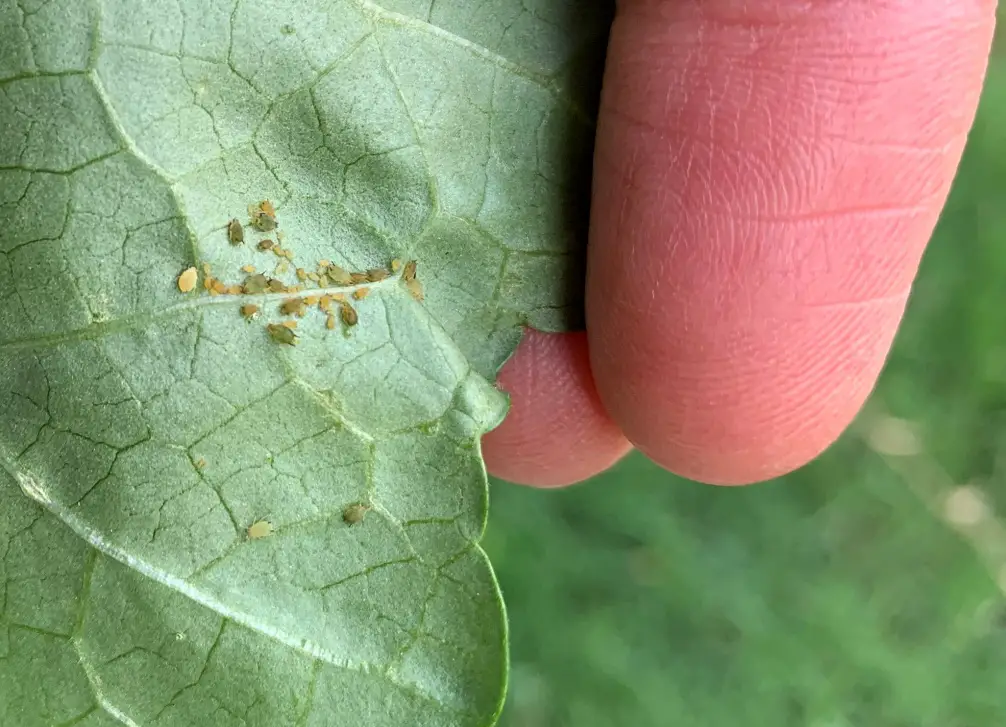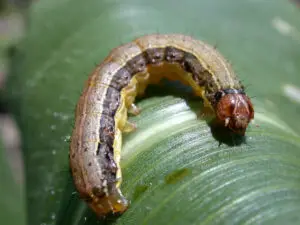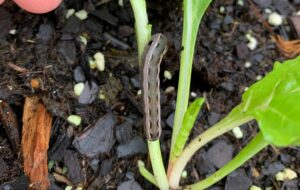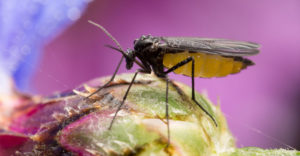What Are Aphids?
If you’ve been gardening for any length of time, chances are you’ve encountered aphids. These tiny, 1/8″ to 1/4″ long, soft-bodied, insects are equal opportunity destroyers, setting up camp on stems and the underside of leaves. There are several hundred varieties of aphids that attack food crops, and they vary in shape from oval to tear-drop. They come in a variety of colors as well, including white, green, yellow, brown, red, and black.
Although their small size makes it difficult to distinguish their features, upon closer examination, you may be able to observe the two short, tubular appendages, or cornicles, at the rear of their bodies. This unique feature helps to distinguish them from all other insects.
Most aphids do not have wings, but some species will grow them if the colony becomes too dense, making it possible for them to fly to another plant for food.
Damage
These small, seemingly innocuous insects, can reproduce asexually which enables them to form colonies that can quickly lead to a full-blown infestation. They are perhaps best known for honeydew, the sticky substance they secrete on plants. This sweet substance not only promotes the growth of black sooty mold, but it also attracts ants. The ants feed on the honeydew and, in turn, protect the aphids from any threat posed by predatory insects.
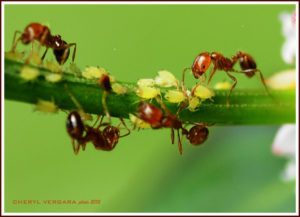
In addition, like other insects, aphids can spread viruses from plant to plant. They pose a more direct threat, however, because they suck the sap out of the host plant preventing it from getting the nutrients it needs. As a result, the leaves may curl or appear misshapen, as well as turn yellow and wilt.
Aphids will attack a wide variety of plants, but for the home vegetable garden, squash, cucumber, and lettuces are some of their favorites. I’ve also found them on my okra and butternut squash plants.
How to Organically Treat and Prevent Aphids
If you find aphids on your plants, don’t panic. Here are nine methods to help eradicate them. You may need to muster up a little perseverance and use more than one method.
1. Smash Them
If the aphids are few in number you can kill them by hand. This is typically what I’ve done whenever I’ve discovered them hiding under plant leaves. It’s quick, cheap, and effective. The key is to inspect your plants often, daily if possible, so that any issues are noticed early before they get out of hand.
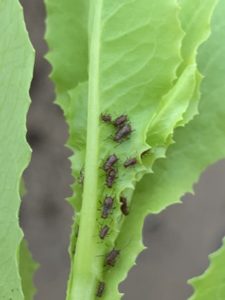
2. Spray Water
In addition, you can treat aphids by simply spraying them with a steady stream of water from the garden hose. They are easily knocked off your plant and you may not have to do much more. Nevertheless, it would be wise to keep an eye out for more and to consider treating the plant with method #4 to prevent their return.
3. Prune Heavily Invested Leaves
It may be necessary to prune the leaf if it’s heavily infested with aphids. Then follow up with one of the other treatments to prevent infestation of the rest of the plant.
This article contains affiliate links. If you make a purchase using one of these links I will receive a very small commission at no additional cost to you, and it will help me maintain this website. Rest assured, I only recommend products I actually like!
4. Homemade Insecticidal Soap
Mix 1-2 teaspoons of liquid dish soap, preferably a Castile soap like Dr. Bronner’s or Dr. Wood’s, in one quart of water (or 1 tablespoon in one gallon of water). Other recipes call for an additional surfactant such as vegetable oil to help the spray stick to the plant’s surface and to reduce any suds or foam. Add 1-2 teaspoons per quart or 1 tablespoon per gallon.
Always do a spray test on a leaf and wait 24 to 48 hours to make sure the plant isn’t negatively affected, only the aphids. If the solution “burns” the plant, dilute the solution and try again. Once you’ve determined the solution is safe for that particular variety, spray all surfaces of the plant, especially the underside of leaves where they like to hide. Repeat every few days until the aphids are gone.
5. Neem Oil
Neem oil, derived from the seeds of the Indian neem tree, is an effective treatment for aphids. It doesn’t work like chemical sprays that kill the insects almost immediately. Rather, neem oil acts to repel the insects as well as to interfere with the insects’ hormones, preventing them from reaching maturity and thereby reproducing.
You can purchase premade neem oil sprays but be sure to check the label to see if any harmful chemicals have not been added. Alternatively, you can make your own spray by mixing 1-2 teaspoons of pure, cold-pressed neem oil (this is the one I use), 1/2 teaspoon of Castile soap, and 1 quart of water. Monitor the plant and apply every seven days or so. Again, always do a spray test on a leaf and wait 24 to 48 hours to see results before spraying the rest of the plant. This is the sprayer I use.
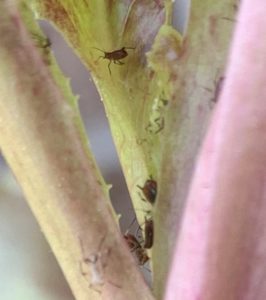
6. Diatomaceous Earth
Sprinkle food-grade diatomaceous earth on plant surfaces and soil. These powdered remains of fossilized organisms kill aphids by cutting their soft bodies as they come into contact with the powder. You will have to reapply if it rains or the plant gets wet. Take care to wear eye protection, and do not inhale the powder as it can potentially harm your lungs.
7. Introduce Beneficial Insects
Fortunately, for the home gardener, aphids have enemies. Introduce these predator insects to help you get rid of the unwanted sapsuckers. The top three predators are ladybugs (lady beetles), parasitic wasps, and green lacewings. You can purchase these beneficial insects online or at your local nursery. As a preventative, you can also try planting cosmos, mint, fennel, dill, and dandelions, to attract the beneficial insects to your garden so you’ll be ready if aphids come to visit.
8. Stop Using Fertilizers High in Nitrogen
Nitrogen promotes foliage growth, which in turn draws aphids who enjoy feeding on the tender new leaves. Instead, try using an organic fertilizer that is balanced or slightly higher in phosphorus like this one.
9. Companion Plant
Certain plants, like garlic, onion, oregano, and sage, put off strong aromas that can deter aphids from making themselves at home in your garden. However, this isn’t always fail-safe as they can fall prey to aphids as well. Conversely, you can grow plants like, nasturtium, verbena, dahlia, calendula, and zinnia, that will attract aphids in an area that is at some distance to your garden so as to lure them away.
Aphids may be small, but they can be a formidable opponent when they colonize. Nevertheless, with a little persistence, you can rid them from your garden.
Thank you for reading this article. Please share it with others you think might find it helpful via email or social media. Thank you!
